|
OCTOBER 2007
���������������������������������������������
back to PARKINSON'S DISEASE home page�������������
31st October 2007 : New research
the
PREVALENce of SLEEP PROBLEMS in parkinson's disease
Movement Disorders [2007] Oct 25; [Epub ahead of
print]
(Verbaan D, van Rooden SM, Visser M,
Marinus J, van Hilten JJ.)
�Complete abstract
 Night
time sleep problems and daytime sleepiness were examined in people with Parkinson's disease. Nearly
half of people with Parkinson's Disease were found to suffer from excessive daytime
sleepiness. Daytime sleepiness was related to age,
dopamine-agonist dose, and disease severity. Night time sleep
problems occurred in more than a
quarter of people with Parkinson's Disease. Women have more night time sleep problems than men,
regardless of whether or not
somebody had Parkinson's Disease. Night time sleep problems were related to
the dosage of dopamine agonists and L-dopa.� Depressive
symptoms were the greatest cause of variance. About 17% of people with Parkinson's
Disease
had to use sleep medications. However, people with� Parkinson's Disease had no more
difficulty falling asleep than
did any other people.
�
30th October 2007 : New research
radiotherapy ceases excessive saliva in parkinson's disease
Movement Disorders [2007] Oct 25; [Epub ahead of
print] (Postma AG, Heesters M, van Laar T.)
Complete abstract
This study investigated retrospectively the long-term efficacy and safety of
radiotherapy to the major salivary glands as a treatment of sialorrhea
(excessive saliva production) in patients with Parkinsonism.
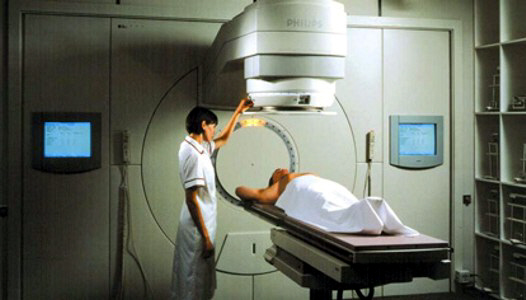 Radiotherapy is usually
the
medical use of
ionizing radiation as part of
cancer
treatment to control
malignant
cells. However, radiotherapy may be used for
other reasons that are unrelated to cancer. For more information go to
Radiotherapy.� The sialorrhea had improved significantly a month after
Radiotherapy. This effect was maintained for at least a year. The most frequent
adverse events were loss of taste and a dry mouth. 75% of these adverse
events were transient. Quality of life had improved significantly in the long
term.�The final follow-up showed that 80% of the patients were satisfied. Radiotherapy is usually
the
medical use of
ionizing radiation as part of
cancer
treatment to control
malignant
cells. However, radiotherapy may be used for
other reasons that are unrelated to cancer. For more information go to
Radiotherapy.� The sialorrhea had improved significantly a month after
Radiotherapy. This effect was maintained for at least a year. The most frequent
adverse events were loss of taste and a dry mouth. 75% of these adverse
events were transient. Quality of life had improved significantly in the long
term.�The final follow-up showed that 80% of the patients were satisfied.
�
� ����������������������������������������������������������������������������������������������������������������������������������������������
�29th October 2007 : New research
physical activity reduces risk of Parkinson's
disease
Movement Disorders [2007] Oct 25; [Epub ahead of
print] (Thacker EL, Chen H, Patel AV, McCullough ML, Calle EE, Thun MJ,
Schwarzschild MA, Ascherio A.)
Complete abstract
The purpose of this study was to investigate associations between recreational
physical activity and Parkinson's disease risk. Recreational physical activity
was estimated from the reported number of hours per week on average
spent
performing light intensity activities (walking, dancing) and moderate to
vigorous intensity activities (jogging/running, lap swimming,
tennis/racquetball, bicycling/ stationary bike, aerobics/calisthenics).�
 The risk of Parkinson's Disease was reduced in those indulging in recreational
physical activity. However, when light activity and moderate to vigorous
activity were examined separately, it was found that only moderate to vigorous
physical activity reduced the risk of Parkinson's Disease. Light activity did
not reduce the likelihood of developing Parkinson's Disease.� Gender made
no difference. The risk of Parkinson's Disease was reduced in those indulging in recreational
physical activity. However, when light activity and moderate to vigorous
activity were examined separately, it was found that only moderate to vigorous
physical activity reduced the risk of Parkinson's Disease. Light activity did
not reduce the likelihood of developing Parkinson's Disease.� Gender made
no difference.
�
28th October 2007 : New research
the
serious effects of parkinson's disease on spouses
Revue Neurologique (Paris) [2007] 163 (8-9) :
801-807 (Dressen C, Brandel JP, Schneider A, Magar Y, Renon D, Ziegler M.)
Complete abstract
Spouses play a major role as care givers for their partners with Parkinson's
disease. This part of family nursing turns out to be so demanding that they
often feel isolated. While spouses may have access to financial and technical
aids, no specific psychological support is available to assist them in coping
with the difficulties they have to face. Supporting and educating spouses thus
appears today to be a real need. Survey data collected shows that
spouses
experience great disarray when faced with the disease.
 Their perception of
Parkinson's disease has a strong anxiety causing effect. Caring for their spouse
day to day creates a permanent atmosphere of stress with an insecure feeling
generating tensions and major frustrations. Most of the spouses do not allow
themselves any break and are overwhelmed with ambivalent feelings. They
experience a kind of hostility towards their spouse and at the same time feel
guilty for their attitude and also for their helplessness. The disease also
leads to an impoverishment of the couples' social network, due to reduced
autonomy and fear of other people's way of looking at them. Their perception of
Parkinson's disease has a strong anxiety causing effect. Caring for their spouse
day to day creates a permanent atmosphere of stress with an insecure feeling
generating tensions and major frustrations. Most of the spouses do not allow
themselves any break and are overwhelmed with ambivalent feelings. They
experience a kind of hostility towards their spouse and at the same time feel
guilty for their attitude and also for their helplessness. The disease also
leads to an impoverishment of the couples' social network, due to reduced
autonomy and fear of other people's way of looking at them.
�
27th October 2007 : News report
DBS
SURGERY causes patients to be impulsive
Doctors have long noticed varying degrees of
impulsiveness due to taking Parkinson's Disease drugs, from making
uncensored remarks to rare cases of extreme behaviour such as compulsive
gambling, shopping, eating or sex. Your brain is supposed to delay you
when you make difficult decisions, but Deep Brain Stimulation (DBS) can
block that signal - providing another
cause of highly impulsive behaviour in Parkinson's Disease. DBS is a
method of reducing symptoms that
uses
electrodes implanted into the brain.
For more information go to
Deep Brain Stimulation.
 Healthy
people and Parkinson's patients on dopamine drugs hesitated briefly when
faced
with win-win or lose-lose choices, allowing
them time to weigh options. However,� DBS patients didn't hesitate
with lose-lose choices, and actually sped up win-win decisions. They were
far found to be far more impulsive. Yet when the implant was switched off,
DBS patients stopped rushing decisions. "Because they don't have those
brakes in place, you need to teach someone to slow down" when faced with
certain decisions.
For more information go to the
Complete article. Healthy
people and Parkinson's patients on dopamine drugs hesitated briefly when
faced
with win-win or lose-lose choices, allowing
them time to weigh options. However,� DBS patients didn't hesitate
with lose-lose choices, and actually sped up win-win decisions. They were
far found to be far more impulsive. Yet when the implant was switched off,
DBS patients stopped rushing decisions. "Because they don't have those
brakes in place, you need to teach someone to slow down" when faced with
certain decisions.
For more information go to the
Complete article.
�
26th October 2007 : History
LEONARDO DA VINCI'S SECRET DESCRIPTION OF
PARKINSON'S DISEASE
 The
Italian artist, engineer and scientist Leonardo da Vinci (1452-1519) also
studied anatomy, physiology and medicine. He often dissected corpses at night in
order to study the body's functions and structures.� Leonardo wrote and
sketched his ideas and observations in secret notebooks, in handwriting that
only he could read. For more information go to
Leonardo da Vinci. Over 300 years before James Parkinson formally described
Parkinson's Disease, Leonardo da Vinci saw people whose symptoms coincided
with the tremors seen in Parkinson's Disease. He
wrote in his notebooks that "you will see.....those who.....move their trembling
parts, such as their heads or hands without permission of the soul; (the) soul
with all its forces cannot prevent these parts from trembling." The
Italian artist, engineer and scientist Leonardo da Vinci (1452-1519) also
studied anatomy, physiology and medicine. He often dissected corpses at night in
order to study the body's functions and structures.� Leonardo wrote and
sketched his ideas and observations in secret notebooks, in handwriting that
only he could read. For more information go to
Leonardo da Vinci. Over 300 years before James Parkinson formally described
Parkinson's Disease, Leonardo da Vinci saw people whose symptoms coincided
with the tremors seen in Parkinson's Disease. He
wrote in his notebooks that "you will see.....those who.....move their trembling
parts, such as their heads or hands without permission of the soul; (the) soul
with all its forces cannot prevent these parts from trembling."
�
25th October 2007 : New research
nicotine greatly reduces dyskinesia
Annals of Neurology [2007] Oct 24; [Epub
ahead of print] (Quik M, Cox H, Parameswaran N, O'Leary K, Langston JW, Di
Monte D.)
Complete abstract
One of the more difficult challenges faced by
some sufferers of Parkinson's Disease is the dyskinesias - the jerky,
uncontrollable movements caused by the most common treatments for
Parkinson's Disease. Scientists report that
monkeys
treated with nicotine had 50% fewer episodes of dyskinesia, compared to
monkeys that did not receive nicotine.
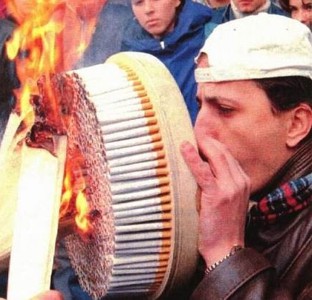 The study appears to be the first
to examine nicotine as a treatment for dyskinesia. It follows on from
far more research showing a reduction of Parkinson's Disease symptoms
because of nicotine.� The study will be published in an upcoming
issue of the Annals of Neurology. The authors point out that nicotine and
smoking is potentially toxic in large doses and can create other health
problems. They
have consequently suggested that may have to develop a different drug that
mimics how nicotine acts, rather than use nicotine itself.
For more information go to the
Complete article. The study appears to be the first
to examine nicotine as a treatment for dyskinesia. It follows on from
far more research showing a reduction of Parkinson's Disease symptoms
because of nicotine.� The study will be published in an upcoming
issue of the Annals of Neurology. The authors point out that nicotine and
smoking is potentially toxic in large doses and can create other health
problems. They
have consequently suggested that may have to develop a different drug that
mimics how nicotine acts, rather than use nicotine itself.
For more information go to the
Complete article.
�
24th October 2007 : News report
EDUCATED
PEOPLE DEVELOP DEMENTIA AT A FASTER RATE
 People
with more years of education lose their memory faster than those with less
education in the years prior to a diagnosis of dementia, according to a study
published in the October 23, 2007, issue of Neurology�. The study found for each
additional year of formal education, the accelerated memory decline associated
with oncoming dementia was delayed by about two-and-a-half months. However, once
that decline stopped, people with more education saw their rate of cognitive
decline accelerate 4% faster for each additional year of education. People with more education had more rapid memory loss
after diagnosis of dementia. The "study showed that a person with 16 years of
formal education would experience a rate of memory decline that is 50% faster
than someone with four years of education." �For more information go to the
Complete article. People
with more years of education lose their memory faster than those with less
education in the years prior to a diagnosis of dementia, according to a study
published in the October 23, 2007, issue of Neurology�. The study found for each
additional year of formal education, the accelerated memory decline associated
with oncoming dementia was delayed by about two-and-a-half months. However, once
that decline stopped, people with more education saw their rate of cognitive
decline accelerate 4% faster for each additional year of education. People with more education had more rapid memory loss
after diagnosis of dementia. The "study showed that a person with 16 years of
formal education would experience a rate of memory decline that is 50% faster
than someone with four years of education." �For more information go to the
Complete article.
�
23rd October 2007 : News report
parkinson's disease SOCIETY URGE FUNDING FOR "bREAKTHROUGH"
The Parkinson's Disease Society is launching
an urgent campaign to raise extra funds in light of what they claim to be
a scientific breakthrough in the treatment of Parkinson's Disease.
The campaign asks donors to help fund a
three year research project at Kings
College London, which will explore what they claim to be groundbreaking
new discoveries in delaying or halting the progress of the disease.
For more information go to the
Complete article. It is
claimed that they
have recently discovered a naturally occuring
protective protein in dopamine-producing nerve
cells
in the brain.
 Osteopontin can interfere with the destruction of nerve
cells that occurs in Parkinson�s disease. It is suggested that this finding may
mean that the causes of Parkinson's rather than just the symptoms can be
treated. It is claimed that Osteopontin empowers the brain to heal itself,
avoiding debilitating side effects that come from using drugs.�For
more information go to the
Parkinson's Disease Society. Osteopontin can interfere with the destruction of nerve
cells that occurs in Parkinson�s disease. It is suggested that this finding may
mean that the causes of Parkinson's rather than just the symptoms can be
treated. It is claimed that Osteopontin empowers the brain to heal itself,
avoiding debilitating side effects that come from using drugs.�For
more information go to the
Parkinson's Disease Society.
The Parkinson's Disease Society and the
same researchers have been
claiming breakthroughs for many years, yet not one of them has led to any
long term improvement in Parkinson's Disease. Their judgement has been proven to be remarkably poor. The scientific claims and theory behind the
requests for funding are fundamentally flawed. Osteopontin is merely an element of bone,
that has been known about for over twenty years.
For more information go to
Osteopontin. The fundamental fault in Parkinson's Disease is known to
be the insufficient formation of dopamine, yet even in theory, their approach could
not have any direct effect on dopamine formation.� So by claiming
this as a breakthrough suggests that neither the funders nor the
researchers have a proper understanding of human biochemistry,� Unfortunately this is
the norm in medical research. Projects are regularly hailed as
"Cure of the month", even though they lack a rational scientific basis.�
"This could lead to.......", but of course it never does.�
�
22nd October 2007 : New research
epilepsy drug for treating parkinson's disease
Expert Review of Neurotherapeutics
[2007] 7 (9) : 1077-1083�
(Miwa H.)
Complete abstract
Zonisamide is an antiepileptic drug used to treat seizures. For more
information go to
Zonegran (Zonisamide). It is claimed that zonisamide may
also be beneficial in various neurological or psychiatric diseases. A
study conducted in Japan provided data suggesting that zonisamide, as an
add-on treatment, has efficacy in treating motor symptoms in
people
with Parkinson's disease. Previous clinical data have been reported. For more information go to the
Complete abstract.
It is claimed
that Zonisamide may be effective in reducing the duration of
"off"
time in people with Parkinson's
Disease
treated with L-Dopa.
 The
therapeutic doses of zonisamide for Parkinson's Disease are considerably lower than those for the treatment of epilepsy. It is expected that zonisamide will be safe and tolerated, as it has been used as an antiepileptic for more than 15
years. However, further studies are required to evaluate its safety and
tolerability in the treatment of Parkinson's Disease. The pharmacological mechanisms of the
actions of zonisamide in Parkinson's Disease remain unclear. Various
hypotheses have been proposed, but supporting data is not sufficient to draw any conclusions. The
therapeutic doses of zonisamide for Parkinson's Disease are considerably lower than those for the treatment of epilepsy. It is expected that zonisamide will be safe and tolerated, as it has been used as an antiepileptic for more than 15
years. However, further studies are required to evaluate its safety and
tolerability in the treatment of Parkinson's Disease. The pharmacological mechanisms of the
actions of zonisamide in Parkinson's Disease remain unclear. Various
hypotheses have been proposed, but supporting data is not sufficient to draw any conclusions.
�
������������������������������������������������������������������������������������������������������������������������������������������������������
21st October 2007 : New research
TRANSDERMAL nicotine for treating parkinson's disease
European Journal of Neurology 2007 Oct 17; [Epub
ahead of print] (Villafane G, Cesaro P, Rialland A, Baloul S, Azimi S,
Bourdet C, Le Houezec J, Macquin-Mavier I, Maison P.)
Complete abstract
 Whether nicotine has therapeutic effects on Parkinson's disease symptoms
is controversial, but high doses and
chronic treatment using nicotine have never been tested. A pilot,
open-label clinical trial was carried out to assess
the
safety and possible efficacy
of chronic high doses of nicotine. Six patients with advanced Parkinson's
Disease received increasing daily doses of transdermal nicotine up
to high levels for four months. All patients but one accepted the target
dose. Nausea and vomiting were frequent but moderate, and occurred in most
of the patients. During the high doses, patients improved their muscular
scores and dopaminergic treatments were reduced. The researchers suggest
the need for a larger and randomized clinical trial. Whether nicotine has therapeutic effects on Parkinson's disease symptoms
is controversial, but high doses and
chronic treatment using nicotine have never been tested. A pilot,
open-label clinical trial was carried out to assess
the
safety and possible efficacy
of chronic high doses of nicotine. Six patients with advanced Parkinson's
Disease received increasing daily doses of transdermal nicotine up
to high levels for four months. All patients but one accepted the target
dose. Nausea and vomiting were frequent but moderate, and occurred in most
of the patients. During the high doses, patients improved their muscular
scores and dopaminergic treatments were reduced. The researchers suggest
the need for a larger and randomized clinical trial.
Smoking is already known to lessen the
likelihood of Parkinson's Disease. The reason why nicotine could have an
effect on Parkinson's Disease is because it affects the acetylcholine
receptors. The effects on acetylcholine receptors antagonise Parkinson's
Disease. For more information go to
Biochemistry of Parkinson's Disease. However, as with the long term
use of most drugs, besides the side effects, there would eventually be an
opposite after effect.
�
20th October 2007 : New research
DOPAMINE AGONIST Fails in its claimed USE
Cochrane Database of Systematic Reviews
[2007] (4) : CD003634 (van Hilten J, Ramaker C, Stowe R, Ives Nj.)
Complete abstract
Drugs that mimic dopamine, such as Bromocriptine (Parlodel), were
introduced as monotherapy or in combination with L-Dopa in order to
prevent or delay the onset of motor complications in patients with
Parkinson's disease. For more
information go to
Bromocriptine. However, the role of Bromocriptine has remained
controversial. So a systematic
review of clinical trials compared
Bromocriptine and L-dopa against L-dopa on its own.
 The quality of many of
the clinical trials of Bromocriptine was found to be poor. The results of
the assessment show no evidence of consistent differences between
treatment groups concerning the occurrence and severity of motor
complications, scores of impairment and disability, or the occurrence of
side effects. The authors conclude that there is no evidence to support
the use of early Bromocriptine with L-dopa as a strategy to prevent or
delay the onset of motor complications in the treatment of�
Parkinson's Disease. The quality of many of
the clinical trials of Bromocriptine was found to be poor. The results of
the assessment show no evidence of consistent differences between
treatment groups concerning the occurrence and severity of motor
complications, scores of impairment and disability, or the occurrence of
side effects. The authors conclude that there is no evidence to support
the use of early Bromocriptine with L-dopa as a strategy to prevent or
delay the onset of motor complications in the treatment of�
Parkinson's Disease.
�
19th
October 2007 : News report
oscar
winning actress dies WITH parkinson's disease
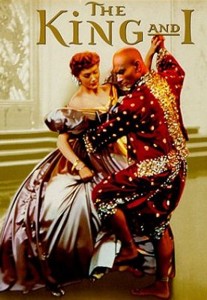 Oscar
winning actress Deborah Kerr (1921�2007) has died
of the complications of Parkinson's Disease. She won an Academy Award and was
nominated six times for an Oscar for best actress. She
starred in dozens of films
including : The King and
I (opposite Yul Brynner), From here to eternity (opposite Burt Lancaster), Quo
Vadis, King Solomon's
mines, Julius Caesar,
The Prisoner of Zenda,
Black Narcissus,
Casino Royale.
For more information go to
Deborah Kerr. She was diagnosed with
Parkinson's Disease several years ago. The illness led her to move from the
Swiss Alps to England, which is where she died.
For more information go to
the
Complete article. Oscar
winning actress Deborah Kerr (1921�2007) has died
of the complications of Parkinson's Disease. She won an Academy Award and was
nominated six times for an Oscar for best actress. She
starred in dozens of films
including : The King and
I (opposite Yul Brynner), From here to eternity (opposite Burt Lancaster), Quo
Vadis, King Solomon's
mines, Julius Caesar,
The Prisoner of Zenda,
Black Narcissus,
Casino Royale.
For more information go to
Deborah Kerr. She was diagnosed with
Parkinson's Disease several years ago. The illness led her to move from the
Swiss Alps to England, which is where she died.
For more information go to
the
Complete article.
�
18th October 2007 : New research
PROFOUND EFFECTS OF DBS ON URINARY FUNCTION
Hinyokika Kiyo (Acta Urologica Japonica) [2007] 53 (9) : 609-612
(Shimizu N, Matsumoto S, Mori Y, Yoshioka N, Uemura H, Nakano N, Taneda M.)
Complete abstract
 Medical
treatments based on L-dopa have limitations in severe Parkinson's disease.
So electric stimulation therapy (DBS) is also used.
Electric stimulation therapy is one of the surgical treatments for
Parkinson's disease whereby a
chronic stimulating electrode is placed on
the subthalmic nucleus. Most Parkinson's disease patients experience lower
urinary tract disorders such as urinary urgency, daytime frequency
or nocturia, which is frequent urination at night. Researchers conducted an analysis on
patients before and after a stimulating electrode was placed. The prostate
symptom score, bladder control and bladder capacity all greatly improved, with the prostate score nearly halving,�
bladder control doubling, and the bladder capacity nearly doubling. Medical
treatments based on L-dopa have limitations in severe Parkinson's disease.
So electric stimulation therapy (DBS) is also used.
Electric stimulation therapy is one of the surgical treatments for
Parkinson's disease whereby a
chronic stimulating electrode is placed on
the subthalmic nucleus. Most Parkinson's disease patients experience lower
urinary tract disorders such as urinary urgency, daytime frequency
or nocturia, which is frequent urination at night. Researchers conducted an analysis on
patients before and after a stimulating electrode was placed. The prostate
symptom score, bladder control and bladder capacity all greatly improved, with the prostate score nearly halving,�
bladder control doubling, and the bladder capacity nearly doubling.
�
17th October 2007 : New research
THE INDISCRIMINATE AND NEGATIVE
EFFECTS OF LONG TERM L-DOPA
Cellular and Molecular Neurobiology [2007]
Oct 13; [Epub ahead of print] (Borah A, Mohanakumar KP.)
Complete abstract
The long term use of L-dopa in Parkinson's Disease was already known to
lead to motor and psychiatric
complications. In the present study,
researchers investigated the long term effects of L-dopa on brain
function.
Serotonin
content was found to be significantly
decreased in all regions of the brain as a result of taking L-dopa.�
Serotonin is what makes people sleep.
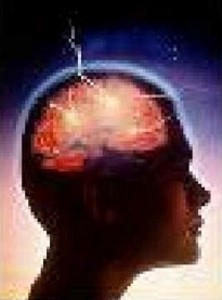 So a lot of the sleep disturbance in
Parkinson's Disease may actually be due to taking L-dopa. Dopamine
formation, which is the primary problem in Parkinson's Disease, was also
found to be severely impaired as a result of taking L-dopa, a substance
that is supposed to increase dopamine formation. The imbalance of
serotonin and dopamine formation may be the cause of overt cognitive,
motor, and psychological functional aberrations seen in Parkinsonian
patients following prolonged L-DOPA treatment. So a lot of the sleep disturbance in
Parkinson's Disease may actually be due to taking L-dopa. Dopamine
formation, which is the primary problem in Parkinson's Disease, was also
found to be severely impaired as a result of taking L-dopa, a substance
that is supposed to increase dopamine formation. The imbalance of
serotonin and dopamine formation may be the cause of overt cognitive,
motor, and psychological functional aberrations seen in Parkinsonian
patients following prolonged L-DOPA treatment.
�
16th October 2007 : History
THE FIRST CLAIMED CURE OF
PARKINSON'S DISEASE IN 1831
 The English physician John Elliotson
(1791-1868) published pamphlets concerning Parkinson's Disease from 1827
to 1831 in the Lancet, which largely consisted of case reports, although
some of those he described probably did not� actually have
Parkinson�s Disease. Amongst his preferred methods of treatment were
bleeding, induction and
maintenance
of
pus building, cauterization, purging, low diet and mercurialization,
silver nitrate, arsenic, zinc sulphate, copper compounds, and the
administration of iron as a tonic with some porter, which is a kind of
dark beer. The English physician John Elliotson
(1791-1868) published pamphlets concerning Parkinson's Disease from 1827
to 1831 in the Lancet, which largely consisted of case reports, although
some of those he described probably did not� actually have
Parkinson�s Disease. Amongst his preferred methods of treatment were
bleeding, induction and
maintenance
of
pus building, cauterization, purging, low diet and mercurialization,
silver nitrate, arsenic, zinc sulphate, copper compounds, and the
administration of iron as a tonic with some porter, which is a kind of
dark beer.
Elliotson made the first known claimed cure. He suggested that
many young patients could be cured, although unreliably, using the
carbonate of iron. On another occasion, John Elliotson reported that the
�disease instantly and permanently gave way� when he treated with iron a
patient who had proved resistant to all other forms of therapy. This was
over a century before iron was found to be essential for the
formation of L-dopa. For more information concerning iron's role in
Parkinson's Disease go to
Biochemistry of Parkinson's Disease.
�
15th October 2007 : New research
Simvastatin reduces the incidence of dementia
and Parkinson's disease
BMC Medicine [2007] 5 : 20 (Wolozin B, Wang
SW, Li NC, Lee A, Lee TA, Kazis LE.)
Complete abstract
Statins are a class of drug that reduce cholesterol. For more
information go to
Statins. Whether statins
could benefit patients with dementia remained unclear because of
conflicting results.
 There are a lot of different statins. So it
was suggested that the contradictions in the scientific literature might arise
from differences in the efficacy of different statins. With further
examination, it was found that Simvastatin is associated with a strong reduction in the incidence of
dementia and Parkinson's disease, whereas Atorvastatin is associated with
a modest reduction in incident dementia and Parkinson's disease. For the
full details go to
Complete text.
How a statin can have an effect on dementia and Parkinson's
Disease is not clear, because it has no direct effect on either. There are a lot of different statins. So it
was suggested that the contradictions in the scientific literature might arise
from differences in the efficacy of different statins. With further
examination, it was found that Simvastatin is associated with a strong reduction in the incidence of
dementia and Parkinson's disease, whereas Atorvastatin is associated with
a modest reduction in incident dementia and Parkinson's disease. For the
full details go to
Complete text.
How a statin can have an effect on dementia and Parkinson's
Disease is not clear, because it has no direct effect on either.
�
������������������������������������������������������������������������������������������������������������������������������������������������������������������������������ 14th October 2007 : New research
increased
risk of dementia in relatives of people with Parkinson disease
Tidsskrift for den Norske
Laegeforening [2007] 127 (19) : 2517-2520 (Halvorsen O, Tysnes OB)
Complete abstract
Archives of Neurology [2007] 64 (10) : 1458-1464 (Rocca
WA, Bower JH, Ahlskog JE, Elbaz A, Grossardt BR, McDonnell SK, Schaid DJ,
Maraganore DM.)
Complete abstract
Dementia in Parkinson's disease is more common than
previously assumed. Up to 30 % of people with Parkinson's have dementia and
almost all patients with Parkinson's disease develop dementia over time.
The risk of dementia or cognitive impairment is also increased in relatives of people
with Parkinson's Disease. This was found to be 1.37
times more likely.
 The likelihood increased to 1.73 times more likely when the onset of Parkinson's
Disease� was earlier than 67 years old. Although the researchers suggested
that this greater likelihood was genetic,� there is no evidence that
genetics play a major part in Parkinson's Disease except in rare cases of
genetic mutation. Relatives often pass on a lot of factors to their children
that are not genetic, such as diet, environment, drug use, supplement use,
physical activity, all of which could alter the likelihood of illness. The likelihood increased to 1.73 times more likely when the onset of Parkinson's
Disease� was earlier than 67 years old. Although the researchers suggested
that this greater likelihood was genetic,� there is no evidence that
genetics play a major part in Parkinson's Disease except in rare cases of
genetic mutation. Relatives often pass on a lot of factors to their children
that are not genetic, such as diet, environment, drug use, supplement use,
physical activity, all of which could alter the likelihood of illness.
�
�����������������������������������������������������������������������������������������������������������������������������������������������������������������������������
13th October 2007 : News report
SEPTINS - A CLAIMED ROLE IN AIDING PARKINSON'S
DISEASE
An unexpected role in the brain has been reported
for septins, which are proteins that enable
a yeast cell to divided into two cells.
For more information go to
Septins.
Septins are also found in
humans - mostly in the brain. It has
been found that septins help neurons sprout
protrusions that enable them to communicate
with other neurons.
Septins
were found to act like scaffolding, enabling other proteins to fulfill their
roles as builders of the cell infrastructure.
 An abundance of septin made the
means by which cells communicate grow and proliferate while a lack of septin
made them small and malformed.
The researchers are
consequently exploring ways to prevent septin breakdown and loss. For more information go to
the
Complete article.
The inadequacy with this approach, is that
it does not, even in theory, increase dopamine formation, which is the primary
fault in Parkinson's Disease. Increasing the communication between nerve cells
simply does not address the problem of� Parkinson's Disease. An abundance of septin made the
means by which cells communicate grow and proliferate while a lack of septin
made them small and malformed.
The researchers are
consequently exploring ways to prevent septin breakdown and loss. For more information go to
the
Complete article.
The inadequacy with this approach, is that
it does not, even in theory, increase dopamine formation, which is the primary
fault in Parkinson's Disease. Increasing the communication between nerve cells
simply does not address the problem of� Parkinson's Disease.
�������������������������������������������������������������������������������������������������������������������������������������������������
����������
�����������������������������������������������������������������������������������������������������������������������������������������������������������������������
12th October 2007 : New research
WORLD'S HIGHEST PREVALENCE OF PARKINSON'S DISEASE
IS DUE TO INDUSTRIAL MANGANESE
American Journal of Industrial Medicine [2007] Oct
4; [Epub ahead of print] (Lucchini RG, Albini E, Benedetti L, Borghesi S,
Coccaglio R, Malara EC, Parrinello G, Garattini S, Resola S, Alessio L.)
Complete abstract
Manganese has been known
to be a potential cause of Parkinson's Disease, particularly in those working
with manganese. For more information got to
Toxic causes of Parkinson's Disease. The prevalence of Parkinson's Disease was assessed in
relationship to environmental exposure to
manganese
due to ferroalloy industries in Brescia, Italy.
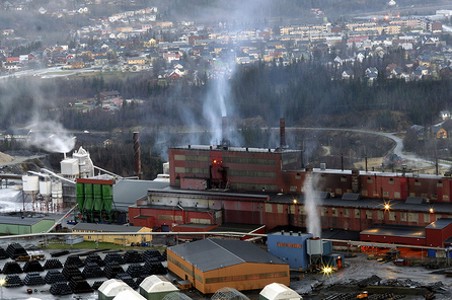 Manganese concentrations
in settled dust were significantly higher in the surroundings and downwind from
the industrial plants. In the vicinities of ferromanganese plants were the
world's highest known prevalence of Parkinson's Disease (407 / 100,000). The
results of this study
suggest that environmental exposure to industrial manganese is strongly associated with
an increased prevalence of
Parkinsonian disturbances. Since the highest
prevalence rates were observed in a closed community of the pre-Alps where the
industries are located, further research may demonstrate a possible interactive
role of genetic factors. Manganese concentrations
in settled dust were significantly higher in the surroundings and downwind from
the industrial plants. In the vicinities of ferromanganese plants were the
world's highest known prevalence of Parkinson's Disease (407 / 100,000). The
results of this study
suggest that environmental exposure to industrial manganese is strongly associated with
an increased prevalence of
Parkinsonian disturbances. Since the highest
prevalence rates were observed in a closed community of the pre-Alps where the
industries are located, further research may demonstrate a possible interactive
role of genetic factors.
�
�����������������������������������������������������������������������������������������������������������������������������������������������������������������������������
11th October 2007 : New research
HEIGHTENED INTEREST IN
gambling, shopping, eating or sex in
Parkinson's disease
Journal of Psychopharmacology [2007] 21 (5) :
501-506 (Giladi N, Weitzman N, Schreiber S, Shabtai H, Peretz C.)
Complete abstract
Alterations of impulse control that have recently been associated with
Parkinson's disease are serious behavioural disturbances with significant impact
on patients and their families. People with Parkinson's Disease were queried on
the presence of new onset heightened interest or drive for gambling, shopping,
eating or sexual activity. These were above the norm, especially in males and
those taking dopamine agonists. Other recent research also found that these
impulse disorders can be caused by dopamine agonists.� For more information
see the
Complete abstract.

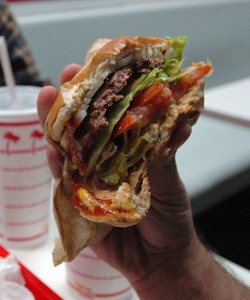
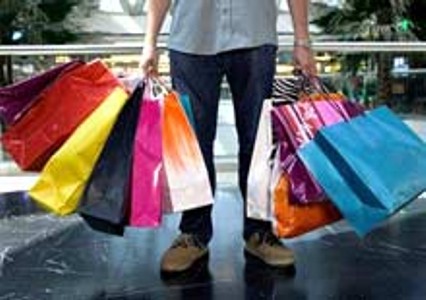
 � �
 � �
 � �

�
11th
October 2007 : News report
MODAFINIL
claimed to REDUCE FATIGUE IN Parkinson's DISEASE
It has been claimed that Modafinil can reduced
physical fatigue commonly seen in patients with Parkinson's disease.
For more information go to
the
Complete article.
Modafinil is approved for the sleep disorder Narcolepsy. For more
information go
to
Modafinil. Although the researchers
claimed that "there's no need to wait to start using
modafinil",
only nine patients were assessed, and the effects were not profound. As the
effects were achieved by artificial means, the body would eventually react
against it.
�
10th October 2007 : New clinical trial results
NEUPRO CLINICAL TRIAL RESULTS
Two clinical trials were carried out on Neupro� (Rotigotine
Transdermal System), a once-daily non-ergolinic dopamine agonist patch. Neupro�
is designed to mimic the action of dopamine, which is a naturally produced
neurotransmitter crucial for proper motor functioning. The system is applied to
the skin once a day and provides rotigotine continuously to the body for 24
hours. 49% of patients showed a 30% improvement or more in early morning motor
function. Nocturnal akinesia - inability to move at night - was reduced by 56%,
and improvement
 was
also noted in nocturnal dystonia - painful muscle contraction - and cramps.
Neupro� improved sleep quality, reduced excessive daytime sleepiness, decreased
night-time urinary symptoms (nocturias). The most frequently reported adverse
events in patients treated with Neupro� were application site reactions (20%),
nausea (19%), and somnolence (11%). was
also noted in nocturnal dystonia - painful muscle contraction - and cramps.
Neupro� improved sleep quality, reduced excessive daytime sleepiness, decreased
night-time urinary symptoms (nocturias). The most frequently reported adverse
events in patients treated with Neupro� were application site reactions (20%),
nausea (19%), and somnolence (11%).
Additionally, new, interim safety data from a
four-year clinical trial were presented. The majority of participants (73%)
remained in the study at 33 months, with 13% discontinuing due to adverse
events. There was a 6.5% incidence of dyskinesia. The most frequently reported
adverse events among patients treated with Neupro� in this trial were somnolence
(41%), application site reactions (23%), most of which were rated as mild (95%),
nausea (18%) and dizziness (20%).
For more information go to
the
Complete article.
Unfortunately, besides the various side effects,
the problem with all dopamine agonists is that they become progressively
counterproductive because they decrease the sensitivity of� the�
dopamine receptors that they initially stimulate. This causes an ever increasing
reliance on dopamine agonists solely in order to maintain the therapeutic effect
that there was at the outset.
�
9th
October 2007 : News report
Parkinson's
Sufferers claiming Chinese Stem Cell Treatment to be Effective
Tiantan Puhua Neurosurgical Hospital, the world's
leading center for treatment of Parkinson's disease using adult retinal stem
cells, has announced that four more international patients returned home from
China with a significant reduction in their Parkinson's Disease symptoms. The
full details and videos of the progress of each of the patients experiences can
be seen at
Stem
Cells China.
For more information go to
the
Complete article.
 It was previously claimed that stem cell therapy was going to cure Parkinson's
Disease. Yet all of the stem cell patients whose experiences are detailed here
still have Parkinson's Disease. Their improvement is quite moderate, and far
from a cure, even according to their own descriptions. The use of stem cells in
Parkinson's Disease is based on the assumption that there is considerable loss
of the cells that produce dopamine. However, not a single study has ever shown
this. Therefore, there is no rational reason to replace these cells using stem
cells. The stem cells will certainly supply the patient with a fresh supply of
dopamine, but this will inevitably run out. So even what improvement there has
been may be short lived. It was previously claimed that stem cell therapy was going to cure Parkinson's
Disease. Yet all of the stem cell patients whose experiences are detailed here
still have Parkinson's Disease. Their improvement is quite moderate, and far
from a cure, even according to their own descriptions. The use of stem cells in
Parkinson's Disease is based on the assumption that there is considerable loss
of the cells that produce dopamine. However, not a single study has ever shown
this. Therefore, there is no rational reason to replace these cells using stem
cells. The stem cells will certainly supply the patient with a fresh supply of
dopamine, but this will inevitably run out. So even what improvement there has
been may be short lived.
�����������������������������������������������������������������������������������������������������������������������������������������������������������������������������������
9th October 2007 : New research
GREATLY INCREASED RISK OF SKIN CANCER IN
PARKINSON'S DISEASE
Cancer Epidemiology Biomarkers Prevention [2007] 16
(6) : 1260-1265 (Driver JA, Logroscino G, Buring JE, Gaziano JM, Kurth T.)
Complete abstract
Previous studies suggested a decreased risk of cancer amongst people with
Parkinson's disease. However, when matched against those of the same age, people
with Parkinson's Disease�have been found to be six times more likely
to develop
Melanoma, which is a type of skin cancer. For more information go to
Melanoma.
 In contrast, people with Parkinson's Disease were less likely to
develop most other cancers - 54% of the normal rate for colorectal cancer, 68% of
the normal rate for bladder cancer, and 74% of the normal rate for prostate
cancer.�The chance of developing lung cancer was only 32% of
the normal rate except for those people with Parkinson's Disease that smoked,
who had nearly double the expected rate of lung cancer. A separate new study has
shown an increased likelihood in Parkinson's Disease of other skin cancers.�
For more information see the
Complete abstract. In contrast, people with Parkinson's Disease were less likely to
develop most other cancers - 54% of the normal rate for colorectal cancer, 68% of
the normal rate for bladder cancer, and 74% of the normal rate for prostate
cancer.�The chance of developing lung cancer was only 32% of
the normal rate except for those people with Parkinson's Disease that smoked,
who had nearly double the expected rate of lung cancer. A separate new study has
shown an increased likelihood in Parkinson's Disease of other skin cancers.�
For more information see the
Complete abstract.
Melanoma may be far more common in
Parkinson's Disease because of their common biochemistry. Parkinson's
Disease is due to a lack of dopamine, which is made from L-tyrosine (L-tyrosine
>>> L-dopa >>> dopamine).
Melanoma becomes much more likely when there is a lack of the skin pigment
melanin, which is also made from L-tyrosine (L-tyrosine >>> L-dopa >>> melanin). So the
high coincidence of Parkinson's Disease and Melanoma may be largely due to a lack of L-tyrosine - a
dietary substance that is normally obtained from eating high protein foods.
����������������
8th October 2007 : New research
SELEGILINE ODT FAILS TO PREVENT THE DETERIORATING
EFFECT OF L-DOPA
Clinical Neuropharmacology
[2007] 30 (5) : 295-300 (Ondo WG, Sethi KD, Kricorian G.)
�Complete abstract
Most patients on long-term
L-Dopa therapy eventually experience deterioration at the end of the L-Dopa
dosing interval.
Selegiline orally disintegrating tablet (ODT), which is marketed as Zelapar is a
selective monoamine
oxidase B inhibitor
developed to extend the effect of L-Dopa. For more information go to
Zelapar. A clinical trial
 was
conducted to see if
it actually had the beneficial effect that was claimed. However, this study
showed that it made no significant difference. The result of this study
contrasts with an identically designed study that showed a significant
improvement after taking Selegiline ODT. was
conducted to see if
it actually had the beneficial effect that was claimed. However, this study
showed that it made no significant difference. The result of this study
contrasts with an identically designed study that showed a significant
improvement after taking Selegiline ODT.
�
7th October 2007 : News report
NEW
COMPOUND FOR DIAGNOSING Parkinson's Disease
As many as 25% of people with Parkinson's Disease
are wrongly diagnosed. Avid Radiopharmaceuticals are conducting a clinical
trial investigating the compound (18)F-AV-133 for imaging
patients
with movement disorders, including Parkinson's Disease, in order to enable
better diagnosis.
 The compound will be
used with Positron emission tomography (PET)
scanning. PET scanning is a means of obtaining a three-dimensional image of
functional processes in the body. In Parkinson's Disease, the image can show if function is reduced.� For more information go to
Positron emission tomography. PET
imaging in this particular case targets vesicular monoamine transporters (VMAT2) in the
brain.� It is suggested by Avid Radiopharmaceuticals that this new compound
may enable more accurate and earlier diagnosis of Parkinson's Disease than the
compounds currently being used.
For more information go to
the
Complete article. The compound will be
used with Positron emission tomography (PET)
scanning. PET scanning is a means of obtaining a three-dimensional image of
functional processes in the body. In Parkinson's Disease, the image can show if function is reduced.� For more information go to
Positron emission tomography. PET
imaging in this particular case targets vesicular monoamine transporters (VMAT2) in the
brain.� It is suggested by Avid Radiopharmaceuticals that this new compound
may enable more accurate and earlier diagnosis of Parkinson's Disease than the
compounds currently being used.
For more information go to
the
Complete article.
�
6th October 2007 : New research
GENEs
CLAIMED TO PROTECT AGAINST PARKINSON'S DISEASE
Nature Cell Biology [2007] Sep 30; [Epub ahead of
print] (Plun-Favreau
H,
Klupsch K,
Moisoi N, Gandhi S, Kjaer S, Frith D, Harvey K,
Deas E, Harvey RJ, McDonald N, Wood NW, Martins LM, Downward J.)�
Complete abstract
It has been claimed that the discovery of a
relationship between two cell enzymes and their role in keeping the cell's
energy generating machinery working smoothly could provide a new target for the
development of therapies for
Parkinson's
disease.
 The products of two genes called HtrA2 and PINK1 have been found to
cooperate in preventing breakdown of cell function that it is claimed could
otherwise lead to Parkinson's symptoms. By protecting the mitochondria (the main
energy producing part of the cells), it is suggested that these two genes help
to limit environmental stress within these cells, and thereby maintain their
healthy function.�
For more information go to
the
Complete article. The products of two genes called HtrA2 and PINK1 have been found to
cooperate in preventing breakdown of cell function that it is claimed could
otherwise lead to Parkinson's symptoms. By protecting the mitochondria (the main
energy producing part of the cells), it is suggested that these two genes help
to limit environmental stress within these cells, and thereby maintain their
healthy function.�
For more information go to
the
Complete article.
The primary fault in idiopathic Parkinson's Disease
is known to be the insufficient formation of dopamine. For more information go to
Biochemistry of Parkinson's Disease. Any method of ridding Parkinson's
Disease would have to increase dopamine formation. Even in theory, information
derived from this study could not do that. Because these two genes cooperate in
preventing cell dysfuntion does not mean that cell damage is the primary cause
of Parkinson's Disease, and contrary to what is widely claimed no such study has
ever demonstrated that it is.
�
6th October 2007 : New research
glutamate is reduced in Parkinson's disease
NMR in
Biomedicine
[2007] Oct 1; [Epub ahead of print] (Griffith HR, Okonkwo OC, O'brien T,
Hollander JA.)
�Complete abstract
Glutamate is a substance in the brain that has widespread biochemical effects.
An understanding of its complete role in Parkinson's disease has
remained elusive. Suggestions have been made that over-activity of Glutamate
receptors complicates the motor symptoms of
Parkinson's
Disease and that Glutmate blockade
may
be a pharmacological target in Parkinson's Disease.�
 However, Glutamate levels
have now been found to be reduced in Parkinson's Disease,
suggesting that a reduction in Glutamate occurs in the cerebral cortex.
Glutamate (Glutamic acid) is normally obtained in the diet from high protein
foods. So somebody can readily increase their intake of Glutamate. For more information go to
Glutamate. In the brain, Glutamate can turn in to GABA, a substance whose deficiency can
cause Dystonia. So the lack of Glutamate now known to occur in Parkinson's Disease
is probably why Dystonia is so common in Parkinson's Disease. However, Glutamate levels
have now been found to be reduced in Parkinson's Disease,
suggesting that a reduction in Glutamate occurs in the cerebral cortex.
Glutamate (Glutamic acid) is normally obtained in the diet from high protein
foods. So somebody can readily increase their intake of Glutamate. For more information go to
Glutamate. In the brain, Glutamate can turn in to GABA, a substance whose deficiency can
cause Dystonia. So the lack of Glutamate now known to occur in Parkinson's Disease
is probably why Dystonia is so common in Parkinson's Disease.
�
5th October 2007 : New research
DBS SURGERY REDUCES CERVICAL (NECK) DYSTONIA
Brain
[2007] Sep 28; [Epub ahead of print] (Kiss
ZH,
Doig-Beyaert K,
Eliasziw M,
Tsui J,
Haffenden A,
Suchowersky O)
�Complete abstract
Deep brain stimulation (DBS) surgery is an
effective treatment for generalized dystonia. For more information go to
Deep Brain Stimulation. Its role in the management of other types of
Dystonia is uncertain.
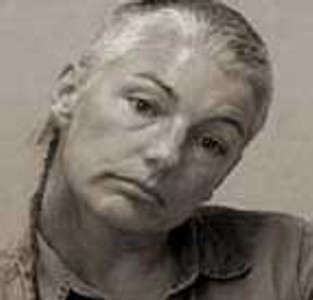 Therefore a study was
performed
assessing the efficacy and safety of DBS in patients
with severe, chronic, medication-resistant cervical
(neck) dystonia.� The severity score improved from an average� of 14.7
(4.2) before surgery to 8.4 (4.4) at 12 months post-operatively. The disability
and pain scores improved from 14.9 (3.8) and 26.6 (3.6) before surgery, to 5.4
(7.0) and 9.2 (13.1) at 12 months, respectively. General health, physical
functioning, and depression improved significantly. Complications
were mild and reversible in four patients. Some changes in neuropsychological
tests were observed, although these did not impact daily life or employment. Therefore a study was
performed
assessing the efficacy and safety of DBS in patients
with severe, chronic, medication-resistant cervical
(neck) dystonia.� The severity score improved from an average� of 14.7
(4.2) before surgery to 8.4 (4.4) at 12 months post-operatively. The disability
and pain scores improved from 14.9 (3.8) and 26.6 (3.6) before surgery, to 5.4
(7.0) and 9.2 (13.1) at 12 months, respectively. General health, physical
functioning, and depression improved significantly. Complications
were mild and reversible in four patients. Some changes in neuropsychological
tests were observed, although these did not impact daily life or employment.
�
4th October 2007 : New research
L-DOPA INCREASES THE PAIN THRESHOLD IN PARKINSON'S
DISEASE
Journal of Neurology, Neurosurgery and Psychiatry
[2007] 78 (10) : 1140-1142 (Gerdelat-Mas A,
Simonetta-Moreau M, Thalamas C, Ory-Magne F, Slaoui T, Rascol O, Brefel-Courbon
C.
)
Complete abstract
Patients suffering from Parkinson's disease
describe painful sensations that could be related to neuropathic pain. The
objective of this study was to assess and compare the effect of L-dopa on the
objective pain threshold in
 patients
with Parkinson's Disease and in healthy subjects. L-dopa significantly increased
the pain threshold of Parkinson's patients in the "Off" condition and the "On"
condition. People with Parkinson's Disease in the "Off" condition were also
found to be more prone to pain than healthy subjects. As L-dopa reduces
excessive muscle contraction, L-dopa will make somebody less prone to the muscle
contraction that can lead to muscular cramps - a problem that can effect people
with or without Parkinson's Disease. patients
with Parkinson's Disease and in healthy subjects. L-dopa significantly increased
the pain threshold of Parkinson's patients in the "Off" condition and the "On"
condition. People with Parkinson's Disease in the "Off" condition were also
found to be more prone to pain than healthy subjects. As L-dopa reduces
excessive muscle contraction, L-dopa will make somebody less prone to the muscle
contraction that can lead to muscular cramps - a problem that can effect people
with or without Parkinson's Disease.
�
3rd October 2007 : New research
THE DIFFERENCE BETWEEN PARKINSON'S AND ALZHEIMER'S
DEMENTIAS
Journal of Neurology, Neurosurgery and Psychiatry
[2007] 78 (10) : 1064-1068 (Bronnick
K,
Emre M,
Lane R,
Tekin S,
Aarsland D)
Complete abstract
Dementia associated with Parkinson's disease is
distinctively different from that seen in Alzheimer's disease. Diagnosis between
the two was predicted from the cognitive profile, with an overall accuracy of
nearly 75%.
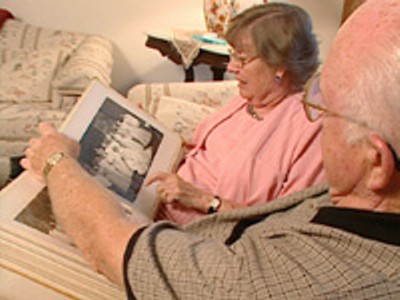 Performance
on tests of orientation and attention were the best in differentiating between
the two, with Alzheimer's patients performing poorly on orientation, and
Parkinson's patients suffering from poor attention. Both groups showed memory
impairment, Alzheimer's disease patients performing worse than Parkinson's
disease dementia patients. On the verbal memory tasks both groups were clearly
impaired relative to a normal control group, with very large effects. Performance
on tests of orientation and attention were the best in differentiating between
the two, with Alzheimer's patients performing poorly on orientation, and
Parkinson's patients suffering from poor attention. Both groups showed memory
impairment, Alzheimer's disease patients performing worse than Parkinson's
disease dementia patients. On the verbal memory tasks both groups were clearly
impaired relative to a normal control group, with very large effects.
For more information go to
the
Complete article.
�
2nd October 2007 : News report
IRON
ACCUMULATION IN parkinson's disease
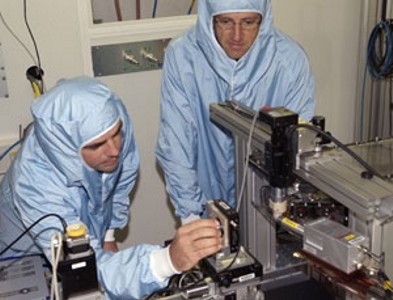 European scientists have developed a new technique
to detect attogram quantities of iron in living cells, claiming
that this
has enabled them provide further evidence of the role that iron plays in
Parkinson's disease. They used
powerful X-ray
radiation
from a synchrotron to track iron in cells cultured from rats. When they compared
the images they got
from normal cells and cells treated to mimic the
onset of Parkinson's disease, they found that iron was accumulating inside
the dopamine storing vesicles of the cells.
because of this they assumed that iron plays a part in
the development of Parkinson's Disease.
For more information go to the
Complete article.� European scientists have developed a new technique
to detect attogram quantities of iron in living cells, claiming
that this
has enabled them provide further evidence of the role that iron plays in
Parkinson's disease. They used
powerful X-ray
radiation
from a synchrotron to track iron in cells cultured from rats. When they compared
the images they got
from normal cells and cells treated to mimic the
onset of Parkinson's disease, they found that iron was accumulating inside
the dopamine storing vesicles of the cells.
because of this they assumed that iron plays a part in
the development of Parkinson's Disease.
For more information go to the
Complete article.�
This
research is based on a false assumption.
Ferrous iron is essential for somebody to be able to form their own L-dopa. Without a sufficient intake of ferrous iron somebody can develop
Parkinson's Disease. For more information go to
Biochemistry of Parkinson's Disease. When L-tyrosine
is not available to form L-dopa, there is also a tendency for iron to accumulate in
order to overcome the lack of L-tyrosine.
This is a common compensatory mechanism in human biochemistry. So instead of
iron accumulation causing Parkinson's Disease,� it is Parkinson's Disease
that can cause the� iron accumulation. Hereditary Hemochromatosis causes
severe iron accumulation. So if iron accumulation really caused Parkinson's Disease, everybody with Hereditary Hemochromatosis would also have the symptoms of Parkinson's Disease, but they don't.
For more information go to
Hereditary Hemochromatosis.
�
ARCHIVES :
�
Current��
December 2008�
November 2008 �October 2008
September 2008
August 2008
July 2008
June
2008
May 2008
April 2008
March 2008� February
2008
January
2008�
December 2007�
November 2007� �October
2007� �September
2007 �August
2007��
July 2007�
�
�
|
.gif)
.gif)

 Radiotherapy is usually
the
Radiotherapy is usually
the
 The risk of Parkinson's Disease was reduced in those indulging in recreational
physical activity. However, when light activity and moderate to vigorous
activity were examined separately, it was found that only moderate to vigorous
physical activity reduced the risk of Parkinson's Disease. Light activity did
not reduce the likelihood of developing Parkinson's Disease.� Gender made
no difference.
The risk of Parkinson's Disease was reduced in those indulging in recreational
physical activity. However, when light activity and moderate to vigorous
activity were examined separately, it was found that only moderate to vigorous
physical activity reduced the risk of Parkinson's Disease. Light activity did
not reduce the likelihood of developing Parkinson's Disease.� Gender made
no difference. Their perception of
Parkinson's disease has a strong anxiety causing effect. Caring for their spouse
day to day creates a permanent atmosphere of stress with an insecure feeling
generating tensions and major frustrations. Most of the spouses do not allow
themselves any break and are overwhelmed with ambivalent feelings. They
experience a kind of hostility towards their spouse and at the same time feel
guilty for their attitude and also for their helplessness. The disease also
leads to an impoverishment of the couples' social network, due to reduced
autonomy and fear of other people's way of looking at them.
Their perception of
Parkinson's disease has a strong anxiety causing effect. Caring for their spouse
day to day creates a permanent atmosphere of stress with an insecure feeling
generating tensions and major frustrations. Most of the spouses do not allow
themselves any break and are overwhelmed with ambivalent feelings. They
experience a kind of hostility towards their spouse and at the same time feel
guilty for their attitude and also for their helplessness. The disease also
leads to an impoverishment of the couples' social network, due to reduced
autonomy and fear of other people's way of looking at them.  Healthy
people and Parkinson's patients on dopamine drugs hesitated briefly when
faced
with win-win or lose-lose choices, allowing
them time to weigh options. However,� DBS patients didn't hesitate
with lose-lose choices, and actually sped up win-win decisions. They were
far found to be far more impulsive. Yet when the implant was switched off,
DBS patients stopped rushing decisions. "Because they don't have those
brakes in place, you need to teach someone to slow down" when faced with
certain decisions.
For more information go to the
Healthy
people and Parkinson's patients on dopamine drugs hesitated briefly when
faced
with win-win or lose-lose choices, allowing
them time to weigh options. However,� DBS patients didn't hesitate
with lose-lose choices, and actually sped up win-win decisions. They were
far found to be far more impulsive. Yet when the implant was switched off,
DBS patients stopped rushing decisions. "Because they don't have those
brakes in place, you need to teach someone to slow down" when faced with
certain decisions.
For more information go to the
 The
Italian artist, engineer and scientist Leonardo da Vinci (1452-1519) also
studied anatomy, physiology and medicine. He often dissected corpses at night in
order to study the body's functions and structures.� Leonardo wrote and
sketched his ideas and observations in secret notebooks, in handwriting that
only he could read. For more information go to
The
Italian artist, engineer and scientist Leonardo da Vinci (1452-1519) also
studied anatomy, physiology and medicine. He often dissected corpses at night in
order to study the body's functions and structures.� Leonardo wrote and
sketched his ideas and observations in secret notebooks, in handwriting that
only he could read. For more information go to
 The study appears to be the first
to examine nicotine as a treatment for dyskinesia. It follows on from
far more research showing a reduction of Parkinson's Disease symptoms
because of nicotine.� The study will be published in an upcoming
issue of the Annals of Neurology. The authors point out that nicotine and
smoking is potentially toxic in large doses and can create other health
problems. They
have consequently suggested that may have to develop a different drug that
mimics how nicotine acts, rather than use nicotine itself.
For more information go to the
The study appears to be the first
to examine nicotine as a treatment for dyskinesia. It follows on from
far more research showing a reduction of Parkinson's Disease symptoms
because of nicotine.� The study will be published in an upcoming
issue of the Annals of Neurology. The authors point out that nicotine and
smoking is potentially toxic in large doses and can create other health
problems. They
have consequently suggested that may have to develop a different drug that
mimics how nicotine acts, rather than use nicotine itself.
For more information go to the
 People
with more years of education lose their memory faster than those with less
education in the years prior to a diagnosis of dementia, according to a study
published in the October 23, 2007, issue of Neurology�. The study found for each
additional year of formal education, the accelerated memory decline associated
with oncoming dementia was delayed by about two-and-a-half months. However, once
that decline stopped, people with more education saw their rate of cognitive
decline accelerate 4% faster for each additional year of education. People with more education had more rapid memory loss
after diagnosis of dementia. The "study showed that a person with 16 years of
formal education would experience a rate of memory decline that is 50% faster
than someone with four years of education." �For more information go to the
People
with more years of education lose their memory faster than those with less
education in the years prior to a diagnosis of dementia, according to a study
published in the October 23, 2007, issue of Neurology�. The study found for each
additional year of formal education, the accelerated memory decline associated
with oncoming dementia was delayed by about two-and-a-half months. However, once
that decline stopped, people with more education saw their rate of cognitive
decline accelerate 4% faster for each additional year of education. People with more education had more rapid memory loss
after diagnosis of dementia. The "study showed that a person with 16 years of
formal education would experience a rate of memory decline that is 50% faster
than someone with four years of education." �For more information go to the
 Osteopontin can interfere with the destruction of nerve
cells that occurs in Parkinson�s disease. It is suggested that this finding may
mean that the causes of Parkinson's rather than just the symptoms can be
treated. It is claimed that Osteopontin empowers the brain to heal itself,
avoiding debilitating side effects that come from using drugs.�For
more information go to the
Osteopontin can interfere with the destruction of nerve
cells that occurs in Parkinson�s disease. It is suggested that this finding may
mean that the causes of Parkinson's rather than just the symptoms can be
treated. It is claimed that Osteopontin empowers the brain to heal itself,
avoiding debilitating side effects that come from using drugs.�For
more information go to the
 The
therapeutic doses of zonisamide for Parkinson's Disease are considerably lower than those for the treatment of epilepsy. It is expected that zonisamide will be safe and tolerated, as it has been used as an antiepileptic for more than 15
years. However, further studies are required to evaluate its safety and
tolerability in the treatment of Parkinson's Disease. The pharmacological mechanisms of the
actions of zonisamide in Parkinson's Disease remain unclear. Various
hypotheses have been proposed, but supporting data is not sufficient to draw any conclusions.
The
therapeutic doses of zonisamide for Parkinson's Disease are considerably lower than those for the treatment of epilepsy. It is expected that zonisamide will be safe and tolerated, as it has been used as an antiepileptic for more than 15
years. However, further studies are required to evaluate its safety and
tolerability in the treatment of Parkinson's Disease. The pharmacological mechanisms of the
actions of zonisamide in Parkinson's Disease remain unclear. Various
hypotheses have been proposed, but supporting data is not sufficient to draw any conclusions.  Whether nicotine has therapeutic effects on Parkinson's disease symptoms
is controversial, but high doses and
chronic treatment using nicotine have never been tested. A pilot,
open-label clinical trial was carried out to assess
the
safety and possible efficacy
of chronic high doses of nicotine. Six patients with advanced Parkinson's
Disease received increasing daily doses of transdermal nicotine up
to high levels for four months. All patients but one accepted the target
dose. Nausea and vomiting were frequent but moderate, and occurred in most
of the patients. During the high doses, patients improved their muscular
scores and dopaminergic treatments were reduced. The researchers suggest
the need for a larger and randomized clinical trial.
Whether nicotine has therapeutic effects on Parkinson's disease symptoms
is controversial, but high doses and
chronic treatment using nicotine have never been tested. A pilot,
open-label clinical trial was carried out to assess
the
safety and possible efficacy
of chronic high doses of nicotine. Six patients with advanced Parkinson's
Disease received increasing daily doses of transdermal nicotine up
to high levels for four months. All patients but one accepted the target
dose. Nausea and vomiting were frequent but moderate, and occurred in most
of the patients. During the high doses, patients improved their muscular
scores and dopaminergic treatments were reduced. The researchers suggest
the need for a larger and randomized clinical trial.  The quality of many of
the clinical trials of Bromocriptine was found to be poor. The results of
the assessment show no evidence of consistent differences between
treatment groups concerning the occurrence and severity of motor
complications, scores of impairment and disability, or the occurrence of
side effects. The authors conclude that there is no evidence to support
the use of early Bromocriptine with L-dopa as a strategy to prevent or
delay the onset of motor complications in the treatment of�
Parkinson's Disease.
The quality of many of
the clinical trials of Bromocriptine was found to be poor. The results of
the assessment show no evidence of consistent differences between
treatment groups concerning the occurrence and severity of motor
complications, scores of impairment and disability, or the occurrence of
side effects. The authors conclude that there is no evidence to support
the use of early Bromocriptine with L-dopa as a strategy to prevent or
delay the onset of motor complications in the treatment of�
Parkinson's Disease. Oscar
winning actress Deborah Kerr (1921�2007) has died
of the complications of Parkinson's Disease. She won an Academy Award and was
nominated six times for an Oscar for best actress. She
starred in dozens of films
including : The King and
I (opposite Yul Brynner), From here to eternity (opposite Burt Lancaster), Quo
Vadis, King Solomon's
mines, Julius Caesar,
The Prisoner of Zenda,
Black Narcissus,
Casino Royale.
For more information go to
Oscar
winning actress Deborah Kerr (1921�2007) has died
of the complications of Parkinson's Disease. She won an Academy Award and was
nominated six times for an Oscar for best actress. She
starred in dozens of films
including : The King and
I (opposite Yul Brynner), From here to eternity (opposite Burt Lancaster), Quo
Vadis, King Solomon's
mines, Julius Caesar,
The Prisoner of Zenda,
Black Narcissus,
Casino Royale.
For more information go to
 Medical
treatments based on L-dopa have limitations in severe Parkinson's disease.
So electric stimulation therapy (DBS) is also used.
Electric stimulation therapy is one of the surgical treatments for
Parkinson's disease whereby a
chronic stimulating electrode is placed on
the subthalmic nucleus. Most Parkinson's disease patients experience lower
urinary tract disorders such as urinary urgency, daytime frequency
or nocturia, which is frequent urination at night. Researchers conducted an analysis on
patients before and after a stimulating electrode was placed. The prostate
symptom score, bladder control and bladder capacity all greatly improved, with the prostate score nearly halving,�
bladder control doubling, and the bladder capacity nearly doubling.
Medical
treatments based on L-dopa have limitations in severe Parkinson's disease.
So electric stimulation therapy (DBS) is also used.
Electric stimulation therapy is one of the surgical treatments for
Parkinson's disease whereby a
chronic stimulating electrode is placed on
the subthalmic nucleus. Most Parkinson's disease patients experience lower
urinary tract disorders such as urinary urgency, daytime frequency
or nocturia, which is frequent urination at night. Researchers conducted an analysis on
patients before and after a stimulating electrode was placed. The prostate
symptom score, bladder control and bladder capacity all greatly improved, with the prostate score nearly halving,�
bladder control doubling, and the bladder capacity nearly doubling.  So a lot of the sleep disturbance in
Parkinson's Disease may actually be due to taking L-dopa. Dopamine
formation, which is the primary problem in Parkinson's Disease, was also
found to be severely impaired as a result of taking L-dopa, a substance
that is supposed to increase dopamine formation. The imbalance of
serotonin and dopamine formation may be the cause of overt cognitive,
motor, and psychological functional aberrations seen in Parkinsonian
patients following prolonged L-DOPA treatment.
So a lot of the sleep disturbance in
Parkinson's Disease may actually be due to taking L-dopa. Dopamine
formation, which is the primary problem in Parkinson's Disease, was also
found to be severely impaired as a result of taking L-dopa, a substance
that is supposed to increase dopamine formation. The imbalance of
serotonin and dopamine formation may be the cause of overt cognitive,
motor, and psychological functional aberrations seen in Parkinsonian
patients following prolonged L-DOPA treatment. The English physician John Elliotson
(1791-1868) published pamphlets concerning Parkinson's Disease from 1827
to 1831 in the Lancet, which largely consisted of case reports, although
some of those he described probably did not� actually have
Parkinson�s Disease. Amongst his preferred methods of treatment were
bleeding, induction and
maintenance
of
pus building, cauterization, purging, low diet and mercurialization,
silver nitrate, arsenic, zinc sulphate, copper compounds, and the
administration of iron as a tonic with some porter, which is a kind of
dark beer.
The English physician John Elliotson
(1791-1868) published pamphlets concerning Parkinson's Disease from 1827
to 1831 in the Lancet, which largely consisted of case reports, although
some of those he described probably did not� actually have
Parkinson�s Disease. Amongst his preferred methods of treatment were
bleeding, induction and
maintenance
of
pus building, cauterization, purging, low diet and mercurialization,
silver nitrate, arsenic, zinc sulphate, copper compounds, and the
administration of iron as a tonic with some porter, which is a kind of
dark beer.
 There are a lot of different statins. So it
was suggested that the contradictions in the scientific literature might arise
from differences in the efficacy of different statins. With further
examination, it was found that Simvastatin is associated with a strong reduction in the incidence of
dementia and Parkinson's disease, whereas Atorvastatin is associated with
a modest reduction in incident dementia and Parkinson's disease. For the
full details go to
There are a lot of different statins. So it
was suggested that the contradictions in the scientific literature might arise
from differences in the efficacy of different statins. With further
examination, it was found that Simvastatin is associated with a strong reduction in the incidence of
dementia and Parkinson's disease, whereas Atorvastatin is associated with
a modest reduction in incident dementia and Parkinson's disease. For the
full details go to
 The likelihood increased to 1.73 times more likely when the onset of Parkinson's
Disease� was earlier than 67 years old. Although the researchers suggested
that this greater likelihood was genetic,� there is no evidence that
genetics play a major part in Parkinson's Disease except in rare cases of
genetic mutation. Relatives often pass on a lot of factors to their children
that are not genetic, such as diet, environment, drug use, supplement use,
physical activity, all of which could alter the likelihood of illness.
The likelihood increased to 1.73 times more likely when the onset of Parkinson's
Disease� was earlier than 67 years old. Although the researchers suggested
that this greater likelihood was genetic,� there is no evidence that
genetics play a major part in Parkinson's Disease except in rare cases of
genetic mutation. Relatives often pass on a lot of factors to their children
that are not genetic, such as diet, environment, drug use, supplement use,
physical activity, all of which could alter the likelihood of illness. An abundance of septin made the
means by which cells communicate grow and proliferate while a lack of septin
made them small and malformed.
The researchers are
consequently exploring ways to prevent septin breakdown and loss. For more information go to
the
An abundance of septin made the
means by which cells communicate grow and proliferate while a lack of septin
made them small and malformed.
The researchers are
consequently exploring ways to prevent septin breakdown and loss. For more information go to
the
 Manganese concentrations
in settled dust were significantly higher in the surroundings and downwind from
the industrial plants. In the vicinities of ferromanganese plants were the
world's highest known prevalence of Parkinson's Disease (407 / 100,000). The
results of this study
suggest that environmental exposure to industrial manganese is strongly associated with
an increased prevalence of
Parkinsonian disturbances. Since the highest
prevalence rates were observed in a closed community of the pre-Alps where the
industries are located, further research may demonstrate a possible interactive
role of genetic factors.
Manganese concentrations
in settled dust were significantly higher in the surroundings and downwind from
the industrial plants. In the vicinities of ferromanganese plants were the
world's highest known prevalence of Parkinson's Disease (407 / 100,000). The
results of this study
suggest that environmental exposure to industrial manganese is strongly associated with
an increased prevalence of
Parkinsonian disturbances. Since the highest
prevalence rates were observed in a closed community of the pre-Alps where the
industries are located, further research may demonstrate a possible interactive
role of genetic factors. 


 �
�
 �
�
 �
�

 was
also noted in nocturnal dystonia - painful muscle contraction - and cramps.
Neupro� improved sleep quality, reduced excessive daytime sleepiness, decreased
night-time urinary symptoms (nocturias). The most frequently reported adverse
events in patients treated with Neupro� were application site reactions (20%),
nausea (19%), and somnolence (11%).
was
also noted in nocturnal dystonia - painful muscle contraction - and cramps.
Neupro� improved sleep quality, reduced excessive daytime sleepiness, decreased
night-time urinary symptoms (nocturias). The most frequently reported adverse
events in patients treated with Neupro� were application site reactions (20%),
nausea (19%), and somnolence (11%).  It was previously claimed that stem cell therapy was going to cure Parkinson's
Disease. Yet all of the stem cell patients whose experiences are detailed here
still have Parkinson's Disease. Their improvement is quite moderate, and far
from a cure, even according to their own descriptions. The use of stem cells in
Parkinson's Disease is based on the assumption that there is considerable loss
of the cells that produce dopamine. However, not a single study has ever shown
this. Therefore, there is no rational reason to replace these cells using stem
cells. The stem cells will certainly supply the patient with a fresh supply of
dopamine, but this will inevitably run out. So even what improvement there has
been may be short lived.
It was previously claimed that stem cell therapy was going to cure Parkinson's
Disease. Yet all of the stem cell patients whose experiences are detailed here
still have Parkinson's Disease. Their improvement is quite moderate, and far
from a cure, even according to their own descriptions. The use of stem cells in
Parkinson's Disease is based on the assumption that there is considerable loss
of the cells that produce dopamine. However, not a single study has ever shown
this. Therefore, there is no rational reason to replace these cells using stem
cells. The stem cells will certainly supply the patient with a fresh supply of
dopamine, but this will inevitably run out. So even what improvement there has
been may be short lived. In contrast, people with Parkinson's Disease were less likely to
develop most other cancers - 54% of the normal rate for colorectal cancer, 68% of
the normal rate for bladder cancer, and 74% of the normal rate for prostate
cancer.�The chance of developing lung cancer was only 32% of
the normal rate except for those people with Parkinson's Disease that smoked,
who had nearly double the expected rate of lung cancer. A separate new study has
shown an increased likelihood in Parkinson's Disease of other skin cancers.�
For more information see the
In contrast, people with Parkinson's Disease were less likely to
develop most other cancers - 54% of the normal rate for colorectal cancer, 68% of
the normal rate for bladder cancer, and 74% of the normal rate for prostate
cancer.�The chance of developing lung cancer was only 32% of
the normal rate except for those people with Parkinson's Disease that smoked,
who had nearly double the expected rate of lung cancer. A separate new study has
shown an increased likelihood in Parkinson's Disease of other skin cancers.�
For more information see the  was
conducted to see if
it actually had the beneficial effect that was claimed. However, this study
showed that it made no significant difference. The result of this study
contrasts with an identically designed study that showed a significant
improvement after taking Selegiline ODT.
was
conducted to see if
it actually had the beneficial effect that was claimed. However, this study
showed that it made no significant difference. The result of this study
contrasts with an identically designed study that showed a significant
improvement after taking Selegiline ODT.  The compound will be
used with Positron emission tomography (PET)
scanning. PET scanning is a means of obtaining a three-dimensional image of
functional processes in the body. In Parkinson's Disease, the image can show if function is reduced.� For more information go to
The compound will be
used with Positron emission tomography (PET)
scanning. PET scanning is a means of obtaining a three-dimensional image of
functional processes in the body. In Parkinson's Disease, the image can show if function is reduced.� For more information go to
 The products of two genes called HtrA2 and PINK1 have been found to
cooperate in preventing breakdown of cell function that it is claimed could
otherwise lead to Parkinson's symptoms. By protecting the mitochondria (the main
energy producing part of the cells), it is suggested that these two genes help
to limit environmental stress within these cells, and thereby maintain their
healthy function.�
For more information go to
the
The products of two genes called HtrA2 and PINK1 have been found to
cooperate in preventing breakdown of cell function that it is claimed could
otherwise lead to Parkinson's symptoms. By protecting the mitochondria (the main
energy producing part of the cells), it is suggested that these two genes help
to limit environmental stress within these cells, and thereby maintain their
healthy function.�
For more information go to
the
 However, Glutamate levels
have now been found to be reduced in Parkinson's Disease,
suggesting that a reduction in Glutamate occurs in the cerebral cortex.
Glutamate (Glutamic acid) is normally obtained in the diet from high protein
foods. So somebody can readily increase their intake of Glutamate. For more information go to
However, Glutamate levels
have now been found to be reduced in Parkinson's Disease,
suggesting that a reduction in Glutamate occurs in the cerebral cortex.
Glutamate (Glutamic acid) is normally obtained in the diet from high protein
foods. So somebody can readily increase their intake of Glutamate. For more information go to
 Therefore a study was
performed
assessing the efficacy and safety of DBS in patients
with severe, chronic, medication-resistant cervical
(neck) dystonia.� The severity score improved from an average� of 14.7
(4.2) before surgery to 8.4 (4.4) at 12 months post-operatively. The disability
and pain scores improved from 14.9 (3.8) and 26.6 (3.6) before surgery, to 5.4
(7.0) and 9.2 (13.1) at 12 months, respectively. General health, physical
functioning, and depression improved significantly. Complications
were mild and reversible in four patients. Some changes in neuropsychological
tests were observed, although these did not impact daily life or employment.
Therefore a study was
performed
assessing the efficacy and safety of DBS in patients
with severe, chronic, medication-resistant cervical
(neck) dystonia.� The severity score improved from an average� of 14.7
(4.2) before surgery to 8.4 (4.4) at 12 months post-operatively. The disability
and pain scores improved from 14.9 (3.8) and 26.6 (3.6) before surgery, to 5.4
(7.0) and 9.2 (13.1) at 12 months, respectively. General health, physical
functioning, and depression improved significantly. Complications
were mild and reversible in four patients. Some changes in neuropsychological
tests were observed, although these did not impact daily life or employment.
 patients
with Parkinson's Disease and in healthy subjects. L-dopa significantly increased
the pain threshold of Parkinson's patients in the "Off" condition and the "On"
condition. People with Parkinson's Disease in the "Off" condition were also
found to be more prone to pain than healthy subjects. As L-dopa reduces
excessive muscle contraction, L-dopa will make somebody less prone to the muscle
contraction that can lead to muscular cramps - a problem that can effect people
with or without Parkinson's Disease.
patients
with Parkinson's Disease and in healthy subjects. L-dopa significantly increased
the pain threshold of Parkinson's patients in the "Off" condition and the "On"
condition. People with Parkinson's Disease in the "Off" condition were also
found to be more prone to pain than healthy subjects. As L-dopa reduces
excessive muscle contraction, L-dopa will make somebody less prone to the muscle
contraction that can lead to muscular cramps - a problem that can effect people
with or without Parkinson's Disease.  Performance
on tests of orientation and attention were the best in differentiating between
the two, with Alzheimer's patients performing poorly on orientation, and
Parkinson's patients suffering from poor attention. Both groups showed memory
impairment, Alzheimer's disease patients performing worse than Parkinson's
disease dementia patients. On the verbal memory tasks both groups were clearly
impaired relative to a normal control group, with very large effects.
Performance
on tests of orientation and attention were the best in differentiating between
the two, with Alzheimer's patients performing poorly on orientation, and
Parkinson's patients suffering from poor attention. Both groups showed memory
impairment, Alzheimer's disease patients performing worse than Parkinson's
disease dementia patients. On the verbal memory tasks both groups were clearly
impaired relative to a normal control group, with very large effects.
 European scientists have developed a new technique
to detect attogram quantities of iron in living cells, claiming
that this
has enabled them provide further evidence of the role that iron plays in
Parkinson's disease. They used
powerful X-ray
radiation
from a synchrotron to track iron in cells cultured from rats. When they compared
the images they got
from normal cells and cells treated to mimic the
onset of Parkinson's disease, they found that iron was accumulating inside
the dopamine storing vesicles of the cells.
because of this they assumed that iron plays a part in
the development of Parkinson's Disease.
For more information go to the
European scientists have developed a new technique
to detect attogram quantities of iron in living cells, claiming
that this
has enabled them provide further evidence of the role that iron plays in
Parkinson's disease. They used
powerful X-ray
radiation
from a synchrotron to track iron in cells cultured from rats. When they compared
the images they got
from normal cells and cells treated to mimic the
onset of Parkinson's disease, they found that iron was accumulating inside
the dopamine storing vesicles of the cells.
because of this they assumed that iron plays a part in
the development of Parkinson's Disease.
For more information go to the